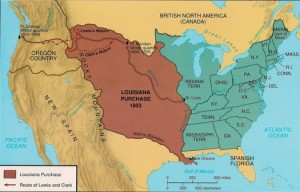The Louisiana Purchase was the largest real estate deal in history and one of the most important achievements of the Jefferson administration. In 1803 the US government bought 828,000 square miles (2’140,000 square km) of land from France for $15 million or about 4 cents per acre. It doubled the size of the American territory.
The newly purchased territory covered land encompassed between the Mississippi River in the east to the Rocky Mountains in the west and from the Gulf of Mexico in the south to the Canadian border in the north. Today all or parts of the following 15 states were formed from the Louisiana territories: Arkansas, Missouri, Iowa, Oklahoma, Kansas, Nebraska, Minnesota, North Dakota, South Dakota, New Mexico, Texas, Montana, Wyoming, Colorado and Louisiana. It also covered part of the Canadian provinces of Alberta and Saskatchewan.
The territory acquired from France known as the Louisiana Purchase, in brown, doubled the size of the United States in 1803. Click on the map to enlarge.
French ownership
By mid 18th century France controlled the territory from New Orleans to the Great Lakes in the north. After the French Indian War, France ceded French Louisiana to Spain. In 1801 Spain, no longer a world power, found itself short of cash and signed a secret agreement with France returning all the French Louisiana territory back to France. France under Napoleon had been trying to put down a revolution in Haiti and preparing to fight Britain and found itself in financial difficulty. Unable to provide resources to defend faraway lands decided to sell the entire territory to the United States. Future president, then Secretary of State, James Madison led the negotiations. The treaty was dated April 30 and signed on May 2. In October Congress approved the deal by 24 votes against 7. In December the US assumed possession of the land.
Consequences of the Louisiana Purchase
The government sponsored many groups to explore the land west of the Mississippi River, the most popular being the Lewis and Clark Expedition. Migration was led by missionaries with the objective to spread Christianity and by economic interest such as fur trading and mining.
The acquisition of the Louisiana lands brought administration and political debates as to the spread of slavery to those lands. As the territory was organized in states, the issue of slavery became a matter of contention and heated debate in Congress. North and south had diverging views. Southern states wanted to continue the institution of slavery while the north was strongly opposed to it.
As Missouri requested admission into the Union it sparked a sectional battle as its admission would break the balance of 11 free and 11 slave states in the Union. In 1820 the Missouri Compromise provided a temporary solution to the conflict.
